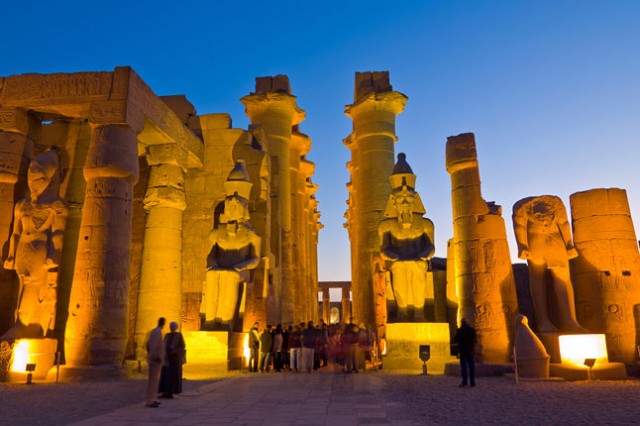Luxor
LUXOR IS LOCATED on the banks of the middle reaches of the NILE RIVER, in Qena governorate, eastcentral EGYPT. Approximately, 440 mi (700 km) south of Cairo, it is a bustling city with a population of about 150,000. As a modern city, it caters to tourists who are attracted to the famous archaeological sites that attest to Egypt's rich history. These are present in the nearby Valley of the Kings and in Denderah and Abydos just to the north, as well as in Luxor itself. The city comprises three areas: the City of Luxor on the east bank of the Nile, Thebes (also known by the ancients as Waset) on the opposite bank, and Karnak to the north.
Luxor was the capital of Middle Egypt for 1500 years. It became prominent in the 21st century B.C.E.; as Thebes it maintained its status as capital until 661 B.C.E. when it was attacked by the Assyrians. Its significance in the ancient world is recorded by Homer, the famous Greek poet who lived in the 8th century B.C.E., as “the city of a hundred gates.” It survived as an influential center until it was destroyed by the Romans in 30 B.C.E. Although it never fully recovered, Luxor has been a place of interest, almost of pilgrimage, for centuries and it ranks as one of the first true tourist destinations.

There is some evidence for settlement in the Luxor area relating to the Old Kingdom of ancient Egypt which had its focus in Upper Egypt, notably in the Nile delta region where the Great Pyramids were constructed and where the capital, Memphis, was located. This period dates from 2686 B.C.E. to 2181 B.C.E. and is represented at Luxor by ancient tombs; one such necropolis is el-Khoka. There may also have been a temple in Karnak, and it seems likely that Luxor (then Waset) was a provincial town.
The Old Kingdom was followed by an Intermediate period from 2180 B.C.E. to 2040 B.C.E., and then the Middle Kingdom from 2040 B.C.E. to 1730 B.C.E. During the Intermediate period, Luxor began to grow in size and significance under the direction of the 7th to 9th dynasties of rulers and achieved capital status during the reign of Mentuhotep of the 11th dynasty, who once again unified Egypt into one kingdom. He also constructed the temple at Deir el-Bahri on the west bank where his mortuary temple is also located. Luxor (then Thebes) benefited from trade. Its location, on the fertile bank of the Nile adjacent to Nubia and the eastern desert, was advantageous for the acquisition and control of resources being traded north to south and east to west. There was a decline in its political status during the 12th dynasty, as the ruler Amenemhat 1 conferred capital status on El-Lisht close to Memphis, but Luxor's religious influence escalated as the local god, Amun, became a principal deity throughout the kingdom. The remains of a temple to Amun, dating from this period, are present at Karnak.
The advent of the New Kingdom, dating from 1552 B.C.E. to 1069 B.C.E., saw Luxor achieve renown as a religious center. It had become a center of life and death. Active worship in its many temples was juxtaposed with the numerous and rich tombs and mortuary temples excavated in the cliffs of the west bank. Included in the latter are the mortuary temples of Rameses II and Seti I as well as the remains of the temple of Amenhotep III. Further west into the desert, so as not to use fertile land, lie the tombs of the Valley of the Kings that have helped to make Egypt so famous. Not least of these is the tomb of the boy king, Tutankhamen of the 18th dynasty, who ruled Egypt from 1361 B.C.E. to 1352 B.C.E. This was discovered in 1922 by Lord George Carnarvon and fueled much renewed interest in Egypt and its history. On the east bank, Luxor and Karnak became the location of major temple complexes whose architecture and inscriptions are testament to the stonecraft and building technology of the Middle and New Kingdoms. The majesty of the temples is encapsulated in the 134 huge columns of Karnak temple's Hypostyle Hall. The temple of Luxor was built by Amenophis III.
Luxor retained some importance during the Late Period from 664 B.C.E. to 30 B.C.E., but its golden age was over. Much later, Christian churches, Islamic mosques, and a tourist infrastructure added to the heterogeneity of one of the world's oldest cities.